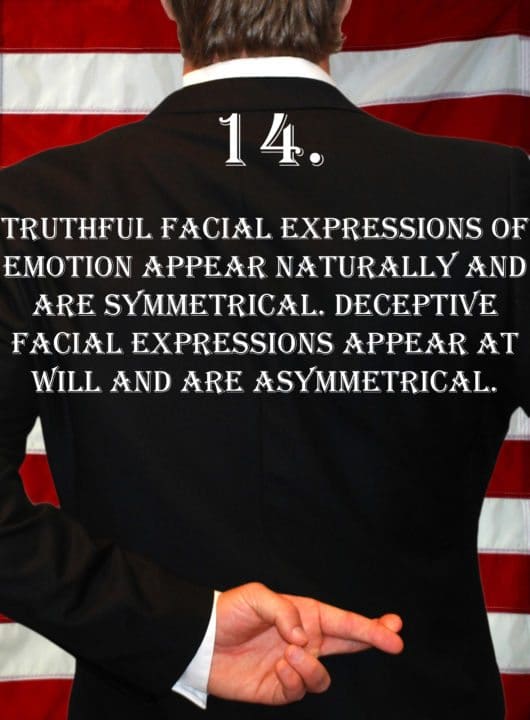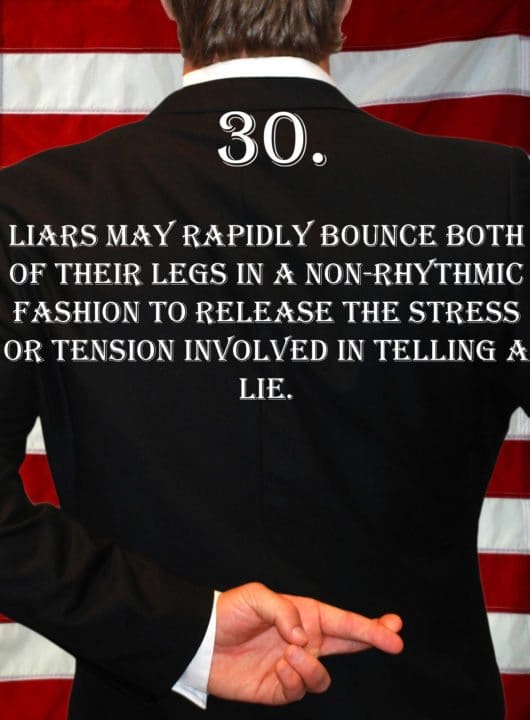
Deception Tip 14:
Truthful facial expressions of emotion appear naturally and are symmetrical. Deceptive facial expressions appear at will and are asymmetrical.
Listen To The Podcast!
E14 – Symmetrical Expressions – Deception Tips Podcast – Click Here To Subscribe
Podcast Transcript
Hello, and welcome to the Deception Tips Podcast, where you will learn amazing cues to detect deceit that will help you read people like never before. I’m your host, Spencer Coffman. Let’s get started.
Welcome to episode 14 of the Deception Tips Podcast. I thank you for listening for this long and I hope you continue to subscribe and share this with your friends. Last time, we spoke about a cool deception tip that wasn’t an apparent outward sign.
It was more of a sign where you need to use your intellect and figure out if they are telling the truth or whether or not they are lying. We said there were three important things that you need to do in order to get the truth from that person.
The first one is; to let them speak. You must stay silent. Let the liar talk because they have a burning desire to tell you their story and, as an interrogator or questioner or whomever you call yourself or whatever you want to say, you have the desire to hear what they want to say. Therefore, let them talk.
The next one is that they will continue to speak until they believe that you believe their lie. And that’s coupled with a side-fact that they will also speak until they believe their lie. They are not only trying to talk you into believing the lie but they are also trying to talk themselves into believing their lie.
They’re feeling guilty about what they did, and now they’re feeling guilty again about lying about it. Therefore, they will spend a lot of time trying to not only convince you but also trying to convince themselves.
The third thing is that they will contradict themselves, thereby revealing the truth. Now, this contradiction doesn’t directly reveal the truth. You need to be paying attention to notice that contradiction so that you will know what the truth is. Now, the truth may not always be readily apparent in that contradiction.
For example, if they say one thing right away and then later say the opposite thing, you may not know which one was true. Maybe the first one was a lie and maybe the second one was a truth. That is the typical scenario. Usually, they’re telling the lie first, and then later, when they contradict it, that is the truth.
However, sometimes people could accidentally contradict themselves and one could be true and one could be a lie and you don’t know which one. Therefore, it’s up to you to continually question, reason, and think about the possibilities to determine if the first one (the original story) was a lie or if the contradiction was a lie. That is up to you to figure out.
Today, we are going to talk about a sign of deception that is really a sign of deception. We’re back onto signs of the body, body leakage, and visible signs of deception.
This sign is visible on the face and it has to do with facial expressions of behavior and deception. It’s not a bodily sign. It’s not that form of leakage. It is something that you will witness right on the face and it is something that is pretty hard for people to mask or cover up.
And, it happens in a very, very short period of time. I’m talking about a fraction of a second possibly a fifth or a quarter of a second. It is instant. It is a borderline micro-expression because it could happen right away, instantly, before, and then the person could try to mask it, or conceal it, by covering it up and then accentuating their face, so that you will not be able to notice it as easily.
But, most of the time, people aren’t consciously aware of these things. So, you will be able to see it because it is a pretty obvious sign of deception. The key is, whether or not it actually indicates deception or whether it indicates something else. So, as always, you’ll have to pay attention to some clusters and patterns of behavior.
So, here it is. Deception Tip 14: Truthful facial expressions of emotion appear naturally and are symmetrical. Deceptive facial expressions appear at will and are asymmetrical. Here it is again. Truthful facial expressions of emotion appear naturally and are symmetrical. Deceptive facial expressions appear at will and are asymmetrical.
So, what does this mean? Well, it means when someone is telling the truth, the facial expressions that they express are going to happen on both sides of the face. They happen symmetrically. Obviously, their face may not be symmetrical. Or if people who have had surgery, or something like that, it may not be perfectly symmetrical like a beautiful square that you fold in half or like a snowflake that looks amazing.
But, in general, when people have things that they are expressing on their face as their eyebrows go up, or they smile- you’re going to see both eyebrows go up. You’re going to see both sides of their mouth go up in a smile. You’ll see their eyes wrinkle on both sides of their face.
If they are being deceptive, you will only see it on one side of their face. It will be asymmetrical. So, that means not symmetrical. When you put an ‘a’ in front of a word, typically it means ‘not.’ Some old ancient Greek language thing or Latin thing. Doesn’t matter. They’ll be asymmetrical. So, for example, they may only smile with half of their face. Only one eyebrow may go up.
This is a common thing in many signs of deception. It doesn’t only happen on the face. Oftentimes, we haven’t gotten to this sign yet, but I’m going to give you a sneak peek. When people shrug their shoulders, usually people shrug both shoulders.
When you don’t know something or you don’t believe someone. But, if you only shrug one shoulder, that could be a sign of deception. Because it’s only half your body. You’re only half into it. You’re not 100% committed. You don’t fully believe that what you’re doing is the truth. But, when you believe that it is the truth and when you know it is the truth, your whole body is committed.
This could be the same thing with hand gestures or certain things. When someone is talking, you often see them use both hands to emphasize what they’re saying. Sometimes people may only use one hand or throw it up in an “I don’t know” gesture with their palm kind of turned upward but, if they really don’t know, it’ll be both hands. You’ll see the stereotypical shrug, where they shrug both shoulders, turn both hands upward, and they kind of don’t know.
Sometimes they’ll even dip their head down and their head may go to one side or the other. Obviously, your head can’t go to both sides because you don’t have two heads. So, that won’t be symmetrical. But, the point is, that true facial expressions of emotions appear naturally and are symmetrical.
Deceptive appear at will and are asymmetrical. When I was in college I conducted a study about smiles and I found a lot of results about symmetricality in facial expressions that I’ll tell you about coming up after this.
Would you like to know if you’re being lied to? Lies are everywhere and they could be happening to you. A Guide to Deception is a great book filled with information on how to spot lies. Get your copy today online at spencercoffman.com
When I was in college I conducted a study, or an experiment, to determine whether or not people can determine the difference between a real smile (one that is genuine and that represents feelings of happiness and real true emotion) and a fake smile (which is one that is just kind of a polite, or a social smile given for terms of being polite, or embarrassment, or something like that. It’s just a general smile).
Although this study was specifically dedicated to determining whether or not people could tell the difference between smiles, I also found a lot of results in the symmetricality of smiles.
What I found was smiles that are true and genuine are definitely symmetrical. They really are. Both sides of the cheeks move up. The corners of the lips both go up. The crow’s feet in the corners of the eyes appear in both eyes and a person’s entire face really lights up with that smile. It is just like it’s glowing. Both sides are perfectly symmetrical.
If you snapped a picture at the peak of the smile and then put a piece of paper over the right side, you’ll see the left side is a nice smile. If you flip that paper over onto the left side, you’ll see that the right side is a nice smile.
It’s almost like those little things that you used to get in coloring books where they have a gridline and you could draw the person. And then down below, they had only half the person drawn and you were to complete the other half. It looks just like that. You could flip it over and see on both sides of their face, a symmetrical smile.
However, when you had asymmetrical smiles or fake smiles that weren’t symmetrical, they definitely weren’t symmetrical. They often happened only on one side of the face. Typically, this was the left side of the face. And this is generally what you’re going to see with most emotions and with most signs of deception is they will appear asymmetrically on the left side of the face, or primarily on the left side of the face. They’ll happen there first.
So, you may get feelings of contempt or anger or something, or a slight smile and it kind of happens on the left. It’s that typical archaic smile is what it’s called. From the old paintings of Leonardo Davinci and those other days of ancient, ancient times.
The Mona Lisa has that little archaic smile. Michelangelo often used archaic smiles. They’re just a little smile. Often, it’s just on one side of the mouth and it’s just a little bit of an upturned lip.
These false emotions often show up on the left side of the face. This is primarily because the right brain, which controls the left side of the body, is usually the one that happens with deception or fake emotions.
The left brain, or the left side of the brain, is generally more true and feeling of spontaneous emotion. It happens instantly. And anything spontaneous, any true spontaneous expression, whether you take deception or something like a smile or surprise or fear.
Those are really great expressions to look at the spontaneous-ness of an expression because, in surprise, both eyes light up instantly, the eyebrows sometimes go up and their mouth will drop open. This happens instantly on both sides of the face.
However, if someone fakes surprise, it is usually only on the left side of the face. Their one eyebrow may go up a little bit more. Their mouth may open and be a little bit more on one side than the other. This is because the right side of the brain is more involved in faking emotions than the left side of the brain. That is the spontaneous side.
When you look for these things, you’ll notice that the asymmetrical forms of leakage happen on the left side of the face more than the right. Pay attention to people when they smile and see when they do those polite smiles.
Which corner of their mouth goes up higher? Is it the left or is it the right? Oftentimes, it will be the left. If not, the right may go up higher because they’ve realized that that has a contradiction and they’ve compensated.
So, oftentimes the best bet to determine whether or not these asymmetrical signs are fake emotions is to watch instantly. Because, usually, this asymmetricality is visible within the first fraction of a second. Usually, it’s the first half of a second of that emotion.
It could be the first full second because smiles generally take about four seconds to get to the peak. Whereas other emotions, like surprise, they’re less than a second. So generally, if you look and you figure anything within the first second, probably within the first half of a second, you see any asymmetricality happening there, then you know that emotion is fake.
Now, the person could know that that emotion is fake so their fake smile may start and be more readily realized on the left side of the face in the first fraction of a second, but then the right side comes up to compensate for it. Or it happens instantly on the right side and then the left side comes up to compensate which is why it appears asymmetrically on the left side of the face.
So, there are like three phases that happen. This asymmetricality is displayed immediately on the left side of the face because the right side is fake emotion. Then the left side will chime in. Then, after that, the right side continues kind of overcompensate, to portray that fake emotion.
The right brain controls the left side of the face so it gets a little bit bigger. So, oftentimes you’ll see a person with a fake smile. Their left cheek corner or left mouth corner will be up higher than their right because it is the right brain that is trying to push that fake smile on the left side of the face to make it appear more genuine.
This could happen with any form of emotion, but smiles- it’s very easily visible and very easy to see. Because, typically, when you see a smile, you know what a smile looks like, you know it’s on both sides of the face.
Oftentimes, people who smile fake-ly just kind of put it up there and you may see it up on the right side, then all of a sudden, the left side comes in because they’re trying to overcompensate for that.
The main thing is, anytime that you see asymmetricality on people’s faces, you will know that something is not true. There’s something happening. Where they’re lying, they’re faking that emotion, they don’t really feel that emotion, they’re using some form of facial expression just to be polite, whatever the case is.
If something is asymmetrical on their face, you know that there’s some deception behind there. Of course, you always need to look out for other signs and other patterns, clusters of deception, to determine whether or not that asymmetricality is a result of an emotion or if it is a physical condition.
Perhaps they’ve had some Botox and maybe only one side of their face works properly. Maybe they’ve had some kind of plastic surgery, some nerve damage. You never know. Maybe they had a stroke and half their face doesn’t work or it’s drooping.
There could be any number of reasons why it may not be symmetrical and, until you know those reasons, you can’t definitively determine whether or not they are lying. You need to look for the patterns and the clusters of behavior to reinforce those signs.
I want to thank you for listening to this week’s episode of the Deception Tips Podcast. I encourage you to share it with your friends, subscribe to the feeds, follow the blogs, take a look at my books, and tune in next week for a new Deception Tip.
Video Transcript
Hey, guys, my name is Spencer Coffman. Thank you for tuning in to the deception tips videos. They’re all about teaching you how to read people and detect deception so that you will know when someone is lying to you.
Today we have a cool tip that I kind of previewed a couple times before way back in number 3 and in number 12, with contradictory behaviors and simultaneous gestures, today we are going to talk about symmetrical expressions. So when it comes to body language, deception, people talking, when the natural body is doing what it does best, which is just naturally happening. Everything is occurring as it should, things are symmetrical, they’re in unison, and they happen congruently on both sides of the body and the face.
So, when people are having contradictory behaviors, that is something that is to be suspicious. You can say, “hey wait a minute, this isn’t matching up. It’s contradictory, it contradicts itself,” which could be a red flag for potential deception. In addition, when gestures are not simultaneous, as in they don’t match up with speech and body language, then something may be happening there.
Today with expressions, which primarily facial expressions, they need to happen on both sides of the face symmetrically. If they are not symmetrical, then you know that something may be a little bit off.
So here it is, this is deception tip Number 14: Truthful facial expressions of emotion appear naturally and are symmetrical. Deceptive facial expressions appear at will and are asymmetrical.
So truthful expressions appear naturally. When someone is surprised, the surprise overtakes their face. When they smile with a genuine smile, it’s on both sides of the face. You see their cheeks go up, their eyes wrinkle, etc. It happens simultaneously, symmetrically. However, when they are being deceptive, they happen at will because they’re fake. They are consciously thinking about doing them.
Natural, truthful, emotional expressions happen out of emotion. It’s unconscious. Oftentimes you can’t help it. You can’t hide it. If you’re so excited, sometimes you just can’t contain that excitement. However, deceptive expressions, they happen at will. People may force a smile on, or they may pretend to be polite. Things like that. It’s at will, and it’s asymmetrical. And the reason for this symmetricality and asymmetricality is because our brain has two hemispheres.
So, for simplification, I’m going to call it the left brain and the right brain. However, it’s really the left cerebral hemisphere and the right cerebral hemisphere. But it’s a left brain and right brain. Now, they control opposite sides of the body. So they are contralaterally related. This means that the right brain controls the left side of the body, and the left brain controls the right side of the body. They happen opposite. So when expressions come out on the face, truthful expressions, typically happen on the right side of the face.
False expressions typically come more on the left side of the face to have that false emotion. So the right brain is more active in false emotions. This is why when people smile if you see a real, genuine, natural smile, you’ll see their eyes wrinkle on both sides. However, when people kind of fake a smile, they may just smile a little bit, you’ll notice that it’s the right side that comes up, and then the left side is the one that equals it out as a part of that false emotion.
So they make consciously put it on one side of the face or the other. A lot of it, this isn’t really set in stone but it’s a very good principle, a lot of it has to do as well with whether they are dominant in one side of the brain or the other. You’ve heard that saying, “are you left-brained or right-brained?” In addition, are you left-handed or right-handed? Whichever is dominant, that could also be the side that you portray that fake emotion on first, and then the other side comes in to even it out to make it look more symmetrical. The deception starts to play a role.
So like, if I smile a little bit as a fake smile, you may see it on my right side, then my left side would come up to equal that out, indicating that the right brain was being deceptive to equal out that fake expression that was forced upon my face. Now, this is true in all expressions. They should all be symmetrical, whether it’s surprise, disgust, anything like that, happiness, fear, etc. Especially in deception. Except for contempt.
Contempt is the only expression that is not symmetrical, it is one side of the face only. Keep in mind these expressions happen really, really quickly, so you may not see them. It’s, they happened in like less than a second. However, a typical smile a real, genuine smile, will probably be anywhere from 2 to 4 seconds from start to finish, Fake smiles are either generally really quick or they’re a lot longer than that. They may stay on for 5 to 8 seconds.
So if someone is just continually smiling, like as in for a picture where they’re just standing there and smiling like that, then you kind of know that that’s not really real. But, even if you miss these genuine facial expressions because they’re so quick, many of them are less than a second, less than even a half of a second, you can always look for other signs because there will be other signs on the body that are a lot longer and that last and happen more frequently that you can see and pay attention to.
If this is your first time watching these videos, I would love to have you subscribe to the channel on YouTube. Feel free to comment on any of them with any questions you may have as well. In addition, we’ve got tons of information available on SpencerCoffman.com, books, podcasts, ebooks, blog posts, etc. So feel free to check them out, they’re all dedicated to teaching you exactly what every body is really saying.
Until next time.






